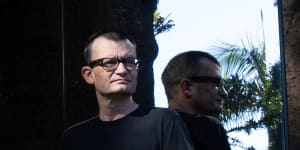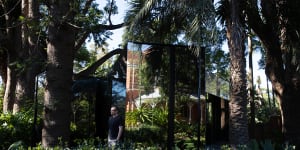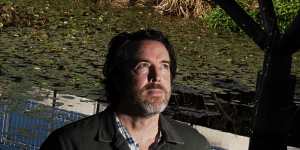That’s a win for Arnold who used smoke and mirrors – in this case a smoky-coloured bronze mirror – to disguise Stealth Pavilion,one of six diverse projects shortlisted in the small project architecture category of this year’s NSW Architecture Awards. “If I have done my work properly,you can’t see it. I’m trying to be as inconspicuous as possible,” Arnold said.

Phillip Arnold wanted the modern pavilion in front of a heritage-listed home in Bellevue Hills to be as inconspicuous as possible. Most people don’t see the wood for the trees.Janie Barrett
Hidden in plain sight,visitors don’t see the guest quarters that are now being used as a gym. Instead,they see reflections of the heritage-listed home’s terracotta shingles,its bay windows,leadlight windows,lawns and lush foliage.
“I’ve doubled the number of trees,” Arnold,of Plus Minus Design,said of the way that the building’s exterior turns the five trees – included in the heritage order – clustered around the pavilion into an urban forest.
The shortlist also includes the new 40-metre Bara Bridge by architect Sam Crawford that links Kensington Pond in Centennial Parklands with the light rail.
Small projects like Bara Bridge often made architects happy but not necessarily rich,said its designer Sam Crawford. “There’s an opportunity to put a lot of effort into something that’s potentially really lovely,beautiful. You can put more love into things you get joy from.”

The reflections make the building blend into its environment.Janie Barrett
Crawford based his design on the bara or (Anguilla reinhardtii) that spend most of their lives in the ponds in Centennial Parklands before swimming to New Caledonia where they were born and where they will spawn and die.
“We wanted to pay tribute to the amazing story of migration. Eels come here to these ponds,and when they reach maturity,they travel to New Caledonia,” he said.
To reach the sea,the eels move stealthily from the ponds’ fresh water to the salt water at Botany Bay by slipping through canals and sliding over lawns. The newborn eels then make their way back to the area,with only one in about one million eels surviving the trip,according to Centennial Parklands.
Researching the design,Crawford and his team visited the ponds,observing the shape,movement and colour of the eels.
“We were just here observing the ponds,and watching a mother and her ducklings swimming along when a large eel popped up,and grabbed a duckling,and,bang,it was gone.”
“As they move,they shimmer,” he said.
The bridge’s railings are made of different coloured anodised aluminium to catch the light in the same way as the eels’ silvery underbelly and light green to dark grey upper body catches the light.
Bara was a valued food source for the Dharawal people,and traces of long-finned eel were found in an 8000-year-old hearth uncovered nearby,according to research by the La Perouse Local Aboriginal Land Council.

Architect Sam Crawford under the Bara Bridge in Centennial Park.Nick Moir
The path leading to the bridge is also curved like an eel,slowing cyclists down. A bulge in the middle of the bridge provides a viewing platform of the water lilies,the fish and the hundreds of birds that cluster near an endangered Eastern Suburbs’ banksia scrub.
“What struck us working on the Parklands is that this is a gateway to the park. There are other gateways,and they are all beautifully designed,but they all commemorate Europeans. There is,to my knowledge,beyond this bridge no commemoration of Indigenous use,” he said.
Other finalists on this year’s shortlist include the upgrade of the Hyde Park Cafe and Museum Station by Andrew Burns Architecture;and The Sanctuary by Welsh and Major,a circular modern memorial wall at Castle Hill cemetery with 2000 niches for the burial of ashes. Two temporary structures were also listed:No Show at Carriageworks by Youssofzay and Hart and Summer Place Pavilion in Albury’s main square by Akimbo Architecture.
Crawford’s firm worked with builders,Christie Civil,and Plus Minus Design worked with Robert Plumb Build.
The Morning Edition newsletter is our guide to the day’s most important and interesting stories,analysis and insights..